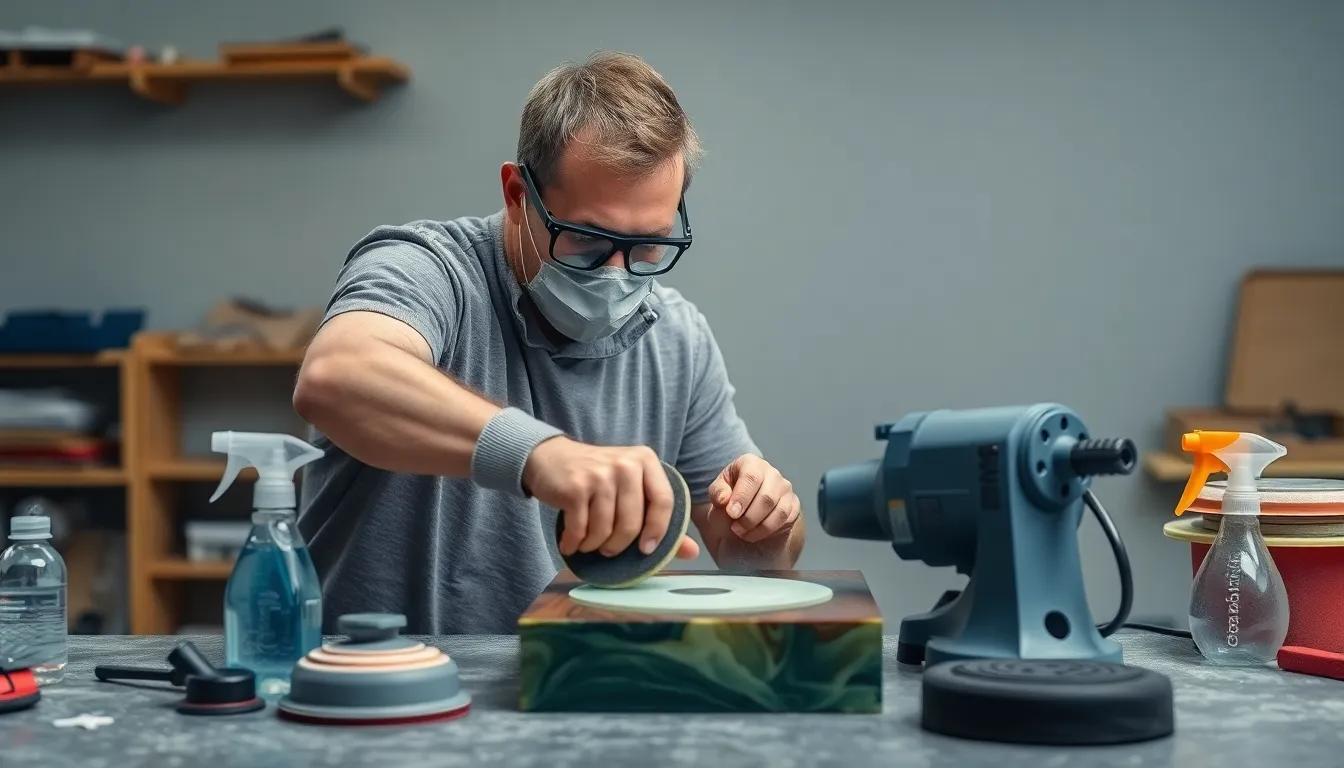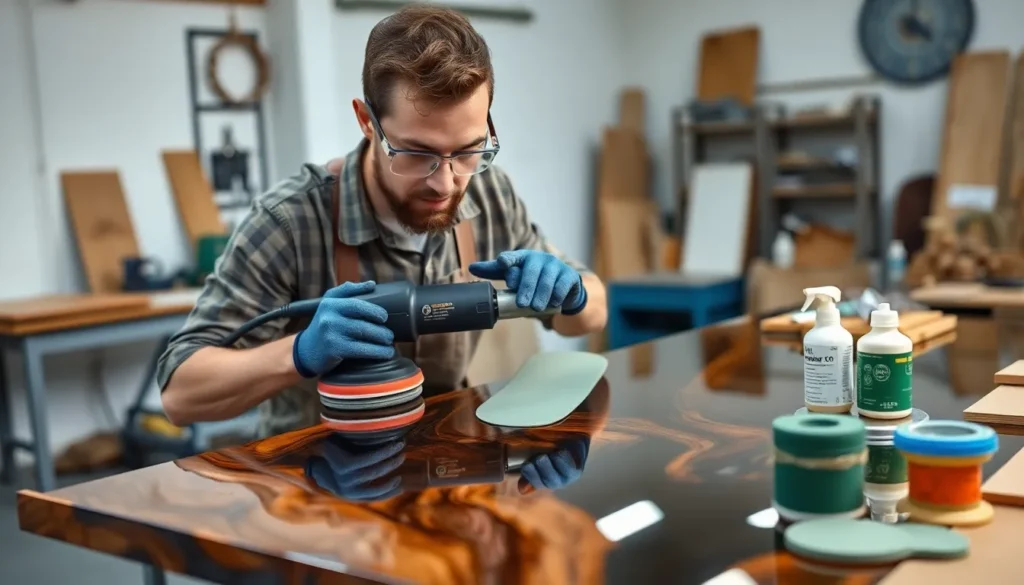Polishing epoxy resin can transform a dull surface into a stunning, glass-like finish. Whether it’s for a tabletop, art project, or jewelry, achieving that perfect shine not only enhances aesthetics but also adds durability. Many crafters and DIY enthusiasts often overlook this crucial final step, but with the right techniques, they can elevate their creations to a professional level.
Understanding the polishing process is key to unlocking the full potential of epoxy resin. From choosing the right tools to mastering the techniques, this guide will walk through the essential steps needed to achieve a flawless finish. With a little patience and practice, anyone can turn their epoxy projects into eye-catching masterpieces that stand out.
Table of Contents
ToggleUnderstanding Epoxy Resin
Epoxy resin is a versatile synthetic polymer known for its strength and durability. This material is commonly used in crafting and industrial applications due to its superior bonding properties.
What Is Epoxy Resin?
Epoxy resin consists of two primary components: a resin and a hardener. When these components mix, they undergo a chemical reaction, creating a rigid and durable material. Epoxy resin features excellent adhesion, chemical resistance, and low shrinkage, making it suitable for a variety of projects. Curing can occur at room temperature or under heat, depending on the specific formulation used.
Common Uses of Epoxy Resin
Epoxy resin finds applications across numerous fields. Here are some common uses:
- Tabletops: Epoxy creates a smooth, glossy finish for wooden tabletops, enhancing aesthetic appeal.
- Art Projects: Artists utilize epoxy to encapsulate objects or create dimensional art pieces with depth.
- Jewelry Making: Crafters use epoxy to create custom jewelry pieces, providing a durable and visually striking finish.
- Coating and Sealing: Epoxy serves as a protective coating for floors, countertops, and other surfaces, safeguarding against damage.
- Repair and Restoration: Repair professionals often implement epoxy to bond materials or fill gaps in damaged surfaces.
These varied uses demonstrate epoxy resin’s adaptability and functional qualities, making it a popular choice for both professionals and hobbyists.
Preparing for Polishing

Polishing epoxy resin requires specific tools and careful preparation to ensure a successful outcome. Following these guidelines can facilitate the polishing process and maintain safety.
Tools and Materials Needed
- Sandpaper: Use a range from 400 to 3000 grit for sanding down the surface. Start with coarser grits for initial smoothing and progress to finer grits for a polished finish.
- Polishing Compound: Select a suitable compound designed for plastic or resin surfaces. A quality compound offers better results and enhances clarity.
- Buffing Pad: Use a soft buffing pad compatible with your polishing tool. The pad helps distribute the compound evenly.
- Polishing Machine: An electric buffer or rotary tool aids in achieving a consistent finish. Ensure it operates at variable speeds to adapt to different polishing stages.
- Clean Cloths: Utilize lint-free cloths for applying the polishing compound and wiping down the surface to avoid scratches.
- Water: A spray bottle of water is used for wet sanding. It minimizes dust and reduces heat during the sanding process.
Safety Precautions
- Protective Gear: Wear safety goggles to protect eyes from particles and a dust mask to avoid inhaling dust and fumes. Nitrile gloves shield hands from chemicals and abrasives.
- Ventilation: Ensure adequate ventilation in the workspace. Open windows or use fans to disperse fumes from the polishing compounds.
- Surface Stability: Secure the epoxy piece on a stable surface during sanding and polishing. This prevents accidents and ensures safer handling.
- Chemical Awareness: Read and follow the manufacturer’s safety instructions for all materials and compounds. Proper understanding prevents hazards related to irritation or allergic reactions.
- Cleanup Procedures: Keep the workspace tidy by cleaning up any spills immediately. Proper disposal of materials and excess dust reduces risks associated with contamination.
Step-by-Step Guide to Polishing Epoxy Resin
Polishing epoxy resin involves several key steps to ensure a smooth, high-gloss finish. Each stage contributes to achieving a professional appearance and enhancing durability.
Initial Sanding
Initial sanding prepares the epoxy surface for polishing. Start with 120-grit sandpaper to remove imperfections. Sand the entire surface evenly, maintaining a consistent motion to avoid uneven spots. Progressively use finer grades, moving to 220-grit and then 400-grit sandpaper. This step eliminates scratches and prepares the surface for polishing compounds. Ensure to cleanup dust and debris between each sanding stage for optimal results.
Selecting the Right Polishing Compound
Selecting the right polishing compound is crucial for achieving a perfect finish. Choose a compound designed specifically for epoxy resin to enhance clarity and shine. Many crafters opt for a two-step process, using a cutting compound first to refine the surface, followed by a finishing compound for a brilliant gloss. Popular brands include Meguiar’s and 3M, known for their effectiveness on epoxy surfaces. Always follow the manufacturer’s instructions for the best outcomes.
Buffing Technique
Effective buffing technique elevates the final appearance of the epoxy resin. Equip a buffing pad to a machine polisher set at a low speed. Apply the polishing compound sparingly to avoid excess buildup. Work in small sections, applying light pressure and moving in circular motions to evenly distribute the polish. Continue buffing until the desired gloss is achieved. Regularly check the pad for buildup and clean it as needed. This technique ensures an even, high-quality finish without damaging the resin.
Tips for a High-Gloss Finish
Achieving a high-gloss finish on epoxy resin demands attention to detail and proper technique. Following the right tips can elevate projects to a professional standard.
Avoiding Common Mistakes
- Skipping Sanding Stages: Skipping progressively finer sanding grades leads to visible scratches. Follow a gradual approach, starting with a coarse grit and finishing with fine grit for a smooth surface.
- Using the Wrong Polishing Compound: Using a compound not suited for epoxy may yield unsatisfactory results. Select compounds specifically designed for resin polishing to ensure optimal sheen.
- Applying Excessive Pressure: Applying too much pressure during buffing can create heat and damage the resin. Use light, even pressure to allow the buffing pad to do the work.
- Neglecting Safety Measures: Neglecting personal safety can result in health risks. Always wear gloves, goggles, and a mask to protect against dust and fumes during the polishing process.
- Overlooking Cleaning: Overlooking cleaning between steps can lead to contamination. Clean surfaces thoroughly with isopropyl alcohol to remove dust and residue before polishing.
Maintaining Your Finish
- Regular Cleaning: Regularly clean epoxy surfaces with a soft cloth dampened with mild soap and water. Avoid abrasive cleaners that can scratch the surface.
- Avoiding Harsh Chemicals: Avoid using harsh chemicals or solvents on the polished resin. These can degrade the finish and affect the glossy appearance.
- Using Coasters and Mats: Using coasters for drinks and mats for hot items can prevent damage from heat and moisture. This helps maintain the integrity and appearance of the finish.
- Controlling Environment: Controlling the environment where the epoxy is displayed can prevent damage. Keeping items away from direct sunlight, excessive humidity, and extreme temperatures preserves their glossy finish.
- Periodic Re-polishing: Periodically re-polishing surfaces can restore shine over time. Utilize a microfiber cloth and a compatible compound to maintain the high-gloss look.
Polishing epoxy resin is a rewarding process that transforms projects into stunning masterpieces. By mastering the techniques and tools outlined, crafters can achieve that coveted glass-like finish while ensuring durability.
With patience and attention to detail, anyone can elevate their work to a professional standard. Regular maintenance and care will keep those beautiful finishes shining bright. Embracing the art of polishing not only enhances the visual appeal but also showcases the versatility of epoxy resin in creative projects.






